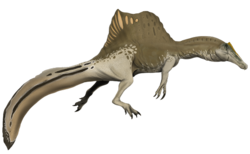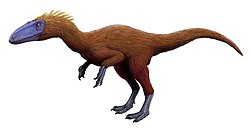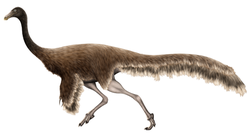Thecocoelurus
| Thecocoelurus | |
|---|---|

| |
| Holotype vertebra | |
| Scientific classification | |
| Kingdom: | Animalia |
| Phylum: | Chordata |
| Class: | Reptilia |
| Clade: | Dinosauria |
| Clade: | Saurischia |
| Clade: | Theropoda |
| Clade: | Neotheropoda |
| Genus: | †Thecocoelurus Huene, 1923 |
| Species: | †T. daviesi
|
| Binomial name | |
| †Thecocoelurus daviesi | |
| Synonyms[1] | |
| |
Thecocoelurus is a genus of theropod dinosaur from the early Cretaceous period of England. Its type specimen was discovered in strata from the Wessex Formation on the Isle of Wight by the Reverend William Fox, and after his death, it, alongside the rest of his collection, became the property of the British Museum of Natural History. The specimen was named in 1888 by Harry Govier Seeley, who assigned it to the genus Thecospondylus . In 1901, it was reassigned by Baron Franz Nopcsa to Coelurus. In 1923, the specimen was removed from either genus by Friedrich von Huene, who assigned it to a genus of its own. Thecocoelurus currently consists of one species, T. daviesi. The validity of the genus has been questioned, with a 2001 publication finding it to be a nomen dubium, although this treatment has not been maintained.
The phylogenetic placement of Thecocoelurus is uncertain. Originally it was believed to be a member of Coeluridae. Subsequently it has been suggested to be an ornithomimid, a more basal ornithomimosaur, an oviraptorosaur similar to caenagnathids, or a European representative of the therizinosaur lineage. In 2011 Darren Naish noted that many of the traits used to unite Thecocoelurus with oviraptosaurs were also found in a more basal theropod group, Noasauridae. Ergo, he suggested that it might have been some kind of ceratosaur.
Discovery and naming
[edit]Thecocoelurus is known from the anterior (front) end of a cervical (neck) vertebra, about a third of its total length. The holotype specimen, NHMUK PV R181, was found in debris from a layer of the Wessex Formation, by the Rev. William Fox on the Isle of Wight. After his death, the Fox Collection was acquired by the British Museum of Natural History. William Davies was the first to notice the specimen and assumed a close affinity with Coelurus. It was described by Harry Govier Seeley in 1888. Seeley named the fossil Thecospondylus daviesi, referring it to a genus he had named earlier based on the incomplete internal cast of a sacrum.[2][3] However, in 1901, Baron Franz Nopcsa renamed it Coelurus daviesi.[4]
In 1923 Friedrich von Huene decided that NHMUK PV R181 should be removed from either Thecospondylus or Coelurus and given its own genus, Thecocoelurus. The generic name is a contraction of Thecospondylus and Coelurus,[5] and translates to "sheathed hollow form".[6]
Description
[edit]As preserved, NHMUK PV R181 measures 39 mm (1.5 in) in length, though Darren Naish theorised that when complete, it may have measured somewhere between 70–90 mm (2.8–3.5 in).[3][6] It is heavily worn and as preserved, lacks prezygapophyses (the superior, or upper, articular processes of the vertebrae). The centrum, the main body of the vertebra, is almost rectangular in cross-section, with a flat anterior (front) articular surface.[3] Above the neural canal was a thin shelf of bone, which in life formed the margin of a deep pit, into which an interspinous ligament would have slotted.[3][6] The parapophyses are long, located anteroventrally (at the front and towards the bottom).[3] A low ridge runs horizontally along each lateral (outer) edge of the vertebral centrum. The ventral (bottom) part of the vertebra had an hourglass-like shape due to the presence of two ridges on the sulcus which merge anteriorly with the parapophyses.[6]
Classification
[edit]Von Huene originally assigned Thecocoelurus to the Coeluridae, but in 1926, speculated based on the large size and typical structure of the vertebra that it belonged instead to an ornithomimid.[7] Though it has been since been typically identified as an indeterminate "coelurian" theropod, Thecocoelurus was reidentified by Darren Naish and colleagues in 2001 as a member of the Oviraptorosauria, a group of omnivorous maniraptoran theropods, which would make it the only oviraptorosaur fossil that has ever been found in Europe. Numerous detailed similarities are shared by the specimen and the cervical vertebrae of caenagnathid oviraptorosaurs. Naish and colleagues regarded Thecocoelurus to be a nomen dubium due to the fragmentary nature of its remains.[6] In 2004, it was theorized by James Kirkland that Thecocoelurus might not be an oviraptorosaur, but a member of the therizinosaur lineage instead, closely related to Falcarius.[8] Revisiting the remains in 2011, Darren Naish treated Thecocoelurus as valid. He noted that many of the traits he formerly used to suggest a caenagnathid identity were also found in noasaurids, members of the more basal theropod lineage Abelisauroidea,[3] citing a paper by Federico L. Agnolin and Agustín G. Martinelli published four years prior.[9] Therefore, he suggested that Thecocoelurus may have been a neoceratosaur, and perhaps a true abelisauroid.[3] A 2014 paper supported the ornithomimosaur hypothesis, and suggested that Thecocoelurus may be a senior synonym of Valdoraptor.[1] Informally, both Darren Naish and Mickey Mortimer have expressed doubt on the idea of Thecocoelurus being an ornithomimosaur,[10][11] with the latter suggesting that it may instead represent a therizinosaur similar to Falcarius.[11]
Palaeoecology
[edit]
The holotype of Thecocoelurus heralds from the Wessex Formation.[3][12] Sedimentological data suggests that the depositional environment of the Wessex Formation was a floodplain intersected by fluvial (river) and lacustrine (lake) deposits. Water levels likely varied throughout the year,[13] due to there being more evaporation than precipitation, though precipitation was regardless quite high. The Wessex seems to have regularly experienced extreme storms[14] and periodic flood events, resulting in debris flows which would have deposited dead organisms in ponds.[15] Burned plant and insect material and fusain suggests that the environment experienced frequent wildfires, stifling for the most part the dense growth of gymnosperms.[13][15] Much of the flora of the formed of low ground cover, consisting primarily of pteridophytes, with occasional stands of conifers, cycads and the tree fern Tempskya.[13] Most vertebrate material from the Wessex Formation originates from plant debris beds, resulting from the aforementioned flooding events.[15]
Aside from Thecocoelurus, the dinosaur fauna of the Isle of Wight includes the theropods Aristosuchus, Calamospondylus, Ceratosuchops, Eotyrannus, Neovenator, Ornithodesmus, Riparovenator and Yaverlandia, the sauropods Chondrosteosaurus, Eucamerotus and Ornithopsis,[16][17] the thyreophorans Polacanthus[17] and Vectipelta,[18] and the ornithopods Brighstoneus,[19] Comptonatus,[20] Hypsilophodon, Iguanodon,[17] Mantellisaurus,[21] Valdosaurus[16][17] and Vectidromeus.[22] The pterosaur fauna of the Wessex Formation consists of Coloborhynchus, Caulkicephalus, Istiodactylus,[23] Vectidraco,[24] and Wightia;[25] multiple unnamed pterosaur taxa, including a ctenochasmatid, are also known.[23] Neosuchian crocodyliforms include Bernissartia, Koumpiodontosuchus[26] and Vectisuchus.[27] Limited evidence exists of elasmosaurids and leptocleidid plesiosaurs.[28] The mammal fauna of the Wessex Formation includes the multituberculate Eobataar[29] and the spalacotheriid Yaverlestes.[30] Albanerpetontid amphibians are represented by Wesserpeton.[31] The fish fauna of the Wessex Formation, both bony and cartilaginous, is extensive, including hybodontiform and modern sharks (Selachii), pycnodontiforms, Lepidotes and Scheenstia.[32] Invertebrates are represented by an assortment of non-biting midges,[33] hymenopterans (wasps) including multiple parasitoid taxa,[34] coleopterans (beetles), the avicularoid spider Cretamygale,[35] and the ostracod Cypridea.[36]
See also
[edit]References
[edit]- ^ a b c R. Allain, R. Vullo, J. Le loeuff & J.-F. Tournepiche (2014) European ornithomimosaurs (Dinosauria, Theropoda): an undetected record. Geologica Acta 12(2) (advance online publication) June 2014.
- ^ Seeley, H.G., 1888, "On Thecospondylus Daviesi (Seeley), with some remarks on the classification of the Dinosauria", Quarterly Journal of the Geological Society of London, 44: 79-86
- ^ a b c d e f g h Naish, Darren (2011). "Theropod dinosaurs". In Batten, David J. (ed.). English wealden fossils. Field guides to fossils. London: Palaeontological Association. pp. 530–532. ISBN 978-1-4443-6711-9.
- ^ Nopcsa, F., 1901. "Synopsis und Abstammung der Dinosaurier", Földtany Közlöny 30 (1901): 247-279
- ^ Huene, F. von, 1923, "Carnivorous Saurischia in Europe since the Triassic", Bulletin of the Geological Society of America, 34: 449-458
- ^ a b c d e Naish, D., Hutt, S. and Martill, D.M., 2001, "Saurichian dinosaurs 2: theropods", In: Martill and Naish (eds). Dinosaurs of the Isle of Wight. The Palaeontological Association. pp. 296–300
- ^ Von Huene, F., 1926, "The carnivorous Saurischia in the Jura and Cretaceous formations, principally in Europe", Revista del Museo de La Plata 29: 35-167
- ^ Kirkland, J. I., Zanno, L. E., DeBlieux, D. D., Smith, D. K., and Sampson, S. D., 2004, "A new, basal-most therizinosauroid (Theropoda: Maniraptora) from Utah demonstrates a Pan-Laurasian distribution for Early Cretaceous therizinosauroids", Journal of Vertebrate Paleontology, 24(3) 78A
- ^ Agnolin, Federico L.; Martinelli, Agustín G. (2007). "Did oviraptorosaurs (Dinosauria; Theropoda) inhabit Argentina?". Cretaceous Research. 28 (5): 785–790. doi:10.1016/j.cretres.2006.10.006.
- ^ Naish, D. (2014, June 3). "Ostrich dinosaurs invade Europe! Or do they?". Retrieved from https://blogs.scientificamerican.com
- ^ a b Mortimer, M. (2014, May 26). "Is Thecocoelurus an ornithomimosaur?". Retrieved from http://theropoddatabase.blogspot.co.uk
- ^ Weishampel, David B; et al. (2004). "Dinosaur distribution (Early Cretaceous, Europe)". In: Weishampel, David B.; Dodson, Peter; and Osmólska, Halszka (eds.): The Dinosauria, 2nd, Berkeley: University of California Press. Pp. 556-563. ISBN 0-520-24209-2.
- ^ a b c Insole, Allan N.; Hutt, Stephen (1994). "The palaeoecology of the dinosaurs of the Wessex Formation (Wealden Group, Early Cretaceous), Isle of Wight, Southern England". Zoological Journal of the Linnean Society. 112 (1–2): 197–215. doi:10.1111/j.1096-3642.1994.tb00318.x.
- ^ Marsden, Marie K.; Gunn, Joshua; Maidment, Susannah C. R.; Nichols, Gary; Wheeley, James R.; Russell, Catherine E.; Boomer, Ian; Stukins, Stephen; Butler, Richard J. (2025-01-06). "Palaeoenvironment and taphonomy of the Hypsilophodon Bed, Lower Cretaceous Wessex Formation, Isle of Wight". Journal of the Geological Society. 182 (1): jgs2024–046. Bibcode:2025JGSoc.182...46M. doi:10.1144/jgs2024-046.
- ^ a b c Pond, Stuart; Strachan, Sarah-Jane; Raven, Thomas J.; Simpson, Martin I.; Morgan, Kirsty; Maidment, Susannah C. R. (2023). "Vectipelta barretti , a new ankylosaurian dinosaur from the Lower Cretaceous Wessex Formation of the Isle of Wight, UK". Journal of Systematic Palaeontology. 21 (1). Bibcode:2023JSPal..2110577P. doi:10.1080/14772019.2023.2210577. ISSN 1477-2019.
- ^ a b Barker, C.T.; Hone, D.; Naish, D.; Cau, A.; Lockwood, J.; Foster, B.; Clarkin, C.; Schneider, P.; Gostling, N. (2021). "New spinosaurids from the Wessex Formation (Early Cretaceous, UK) and the European origins of Spinosauridae". Scientific Reports. 11 (1): 19340. Bibcode:2021NatSR..1119340B. doi:10.1038/s41598-021-97870-8. PMC 8481559. PMID 34588472.
- ^ a b c d Martill, D. M.; Hutt, S. (1996). "Possible baryonychid dinosaur teeth from the Wessex Formation (Lower Cretaceous, Barremian) of the Isle of Wight, England". Proceedings of the Geologists' Association. 107 (2): 81–84. Bibcode:1996PrGA..107...81M. doi:10.1016/S0016-7878(96)80001-0.
- ^ Pond, Stuart; Strachan, Sarah-Jane; Raven, Thomas J.; Simpson, Martin I.; Morgan, Kirsty; Maidment, Susannah C. R. (2023-01-01). "Vectipelta barretti, a new ankylosaurian dinosaur from the Lower Cretaceous Wessex Formation of the Isle of Wight, UK". Journal of Systematic Palaeontology. 21 (1). Bibcode:2023JSPal..2110577P. doi:10.1080/14772019.2023.2210577. ISSN 1477-2019. S2CID 259393929.
- ^ Lockwood, Jeremy A. F.; Martill, David M.; Maidment, Susannah C. R. (2021-11-10). "A new hadrosauriform dinosaur from the Wessex Formation, Wealden Group (Early Cretaceous), of the Isle of Wight, southern England". Journal of Systematic Palaeontology. 19 (12): 847–888. Bibcode:2021JSPal..19..847L. doi:10.1080/14772019.2021.1978005. ISSN 1477-2019. S2CID 244067410.
- ^ Lockwood, Jeremy A. F.; Martill, David M.; Maidment, Susannah C. R. (2024-12-31). "Comptonatus chasei, a new iguanodontian dinosaur from the Lower Cretaceous Wessex Formation of the Isle of Wight, southern England". Journal of Systematic Palaeontology. 22 (1). Bibcode:2024JSPal..2246573L. doi:10.1080/14772019.2024.2346573. ISSN 1477-2019.
- ^ Carpenter, K. & Ishida, Y. (2010). "Early and "Middle" Cretaceous Iguanodonts in Time and Space". Journal of Iberian Geology. 36 (2): 145–164. doi:10.5209/rev_JIGE.2010.v36.n2.3.
- ^ Longrich, Nicholas R.; Martill, David M.; Munt, Martin; Green, Mick; Penn, Mark; Smith, Shaun (2024-02-01). "Vectidromeus insularis, a new hypsilophodontid dinosaur from the Lower Cretaceous Wessex Formation of the Isle of Wight, England". Cretaceous Research. 154 105707. Bibcode:2024CrRes.15405707L. doi:10.1016/j.cretres.2023.105707. ISSN 0195-6671.
- ^ a b Martill, David M.; Coram, Robert A. (2020-08-01). "Additional evidence for very large wing-span pterosaurs in the Wessex Formation (Early Cretaceous, Barremian) of southern England". Proceedings of the Geologists' Association. 131 (3): 293–300. Bibcode:2020PrGA..131..293M. doi:10.1016/j.pgeola.2019.05.002. ISSN 0016-7878.
- ^ Naish, D.; Simpson, M.; Dyke, G. (2013). Farke, Andrew A (ed.). "A New Small-Bodied Azhdarchoid Pterosaur from the Lower Cretaceous of England and Its Implications for Pterosaur Anatomy, Diversity and Phylogeny". PLOS ONE. 8 (3) e58451. Bibcode:2013PLoSO...858451N. doi:10.1371/journal.pone.0058451. PMC 3601094. PMID 23526986.
- ^ Martill, David M.; Green, Mick; Smith, Roy E.; Jacobs, Megan L.; Winch, John (2020-09-01). "First tapejarid pterosaur from the Wessex Formation (Wealden Group: Lower Cretaceous, Barremian) of the United Kingdom". Cretaceous Research. 113 104487. Bibcode:2020CrRes.11304487M. doi:10.1016/j.cretres.2020.104487. ISSN 0195-6671.
- ^ Sweetman, Steven; Pedreira-Segade, Ulysse; Vidovic, Steven (2014). "A new bernissartiid crocodyliform from the Lower Cretaceous Wessex Formation (Wealden Group, Barremian) of the Isle of Wight, southern England". Acta Palaeontologica Polonica. doi:10.4202/app.00038.2013. ISSN 0567-7920.
- ^ Buffetaut, Eric; Hutt, Stephen (1980-07-31). "Vectisuchus leptognathus, n. g. n. sp., a slender-snouted goniopholid crocodilian from the Wealden of the Isle of Wight". Neues Jahrbuch für Geologie und Paläontologie - Monatshefte (7): 385–390. doi:10.1127/njgpm/1980/1980/385.
- ^ Kear, Benjamin P.; Barrett, Paul M. (2011-03-01). "Reassessment of the Lower Cretaceous (Barremian) pliosauroid Leptocleidus superstes Andrews, 1922 and other plesiosaur remains from the nonmarine Wealden succession of southern England". Zoological Journal of the Linnean Society. 161 (3): 663–691. doi:10.1111/j.1096-3642.2010.00648.x. ISSN 0024-4082.
- ^ Sweetman, Steven C. (2009). "A New Species of the Plagiaulacoid Multituberculate Mammal Eobaatar from the Early Cretaceous of Southern Britain". Acta Palaeontologica Polonica. 54 (3): 373–384. doi:10.4202/app.2008.0003. ISSN 0567-7920.
- ^ Sweetman, Steven C. (2008). "A Spalacolestine Spalacotheriid (mammalia, Trechnotheria) from the Early Cretaceous (barremian) of Southern England and Its Bearing on Spalacotheriid Evolution". Palaeontology. 51 (6): 1367–1385. Bibcode:2008Palgy..51.1367S. doi:10.1111/j.1475-4983.2008.00816.x. ISSN 1475-4983.
- ^ Sweetman, Steven; Gardner, James (2013-06-01). "A new albanerpetontid amphibian from the Early Cretaceous (Barremian) Wessex Formation of the Isle of Wight, southern England". Acta Palaeontologica Polonica. 58 (2): 295–324. doi:10.4202/app.2011.0109. ISSN 0567-7920.
- ^ Sweetman, Steven C.; Goedert, Jean; Martill, David M. (2014-11-01). "A preliminary account of the fishes of the Lower Cretaceous Wessex Formation (Wealden Group, Barremian) of the Isle of Wight, southern England". Biological Journal of the Linnean Society. 113 (3): 872–896. doi:10.1111/bij.12369. ISSN 0024-4066.
- ^ Baranov, Viktor; Giłka, Wojciech; Zakrzewska, Marta; Jarzembowski, Edmund (2019-03-01). "New non-biting midges (Diptera: Chironomidae) from Lower Cretaceous Wealden amber of the Isle of Wight (UK)". Cretaceous Research. 95: 138–145. Bibcode:2019CrRes..95..138B. doi:10.1016/j.cretres.2018.11.012. ISSN 0195-6671.
- ^ Perkovsky, Evgeny E.; Olmi, Massimo; Müller, Patrick; Guglielmino, Adalgisa; Jarzembowski, Edmund A.; Capradossi, Leonardo; Rasnitsyn, Alexandr P. (2021-05-01). "A review of the fossil Embolemidae (Hymenoptera: Chrysidoidea), with description of seven new species and history of the family". Cretaceous Research. 121 104708. Bibcode:2021CrRes.12104708P. doi:10.1016/j.cretres.2020.104708. ISSN 0195-6671.
- ^ Selden, Paul A. (2002). "First British Mesozoic Spider, From Cretaceous Amber Of The Isle Of Wight, Southern England". Palaeontology. 45 (5): 973–983. Bibcode:2002Palgy..45..973S. doi:10.1111/1475-4983.00271. hdl:1808/8357. ISSN 1475-4983.
- ^ Penn, Simon J.; Sweetman, Steven C. (2023-03-01). "Microvertebrate-rich gutter casts from the basal Wessex Formation (Wealden Group, Lower Cretaceous) of Dungy Head, Dorset: Insights into the palaeoecology and palaeoenvironment of a non-marine wetland". Cretaceous Research. 143 105397. Bibcode:2023CrRes.14305397P. doi:10.1016/j.cretres.2022.105397. ISSN 0195-6671.














